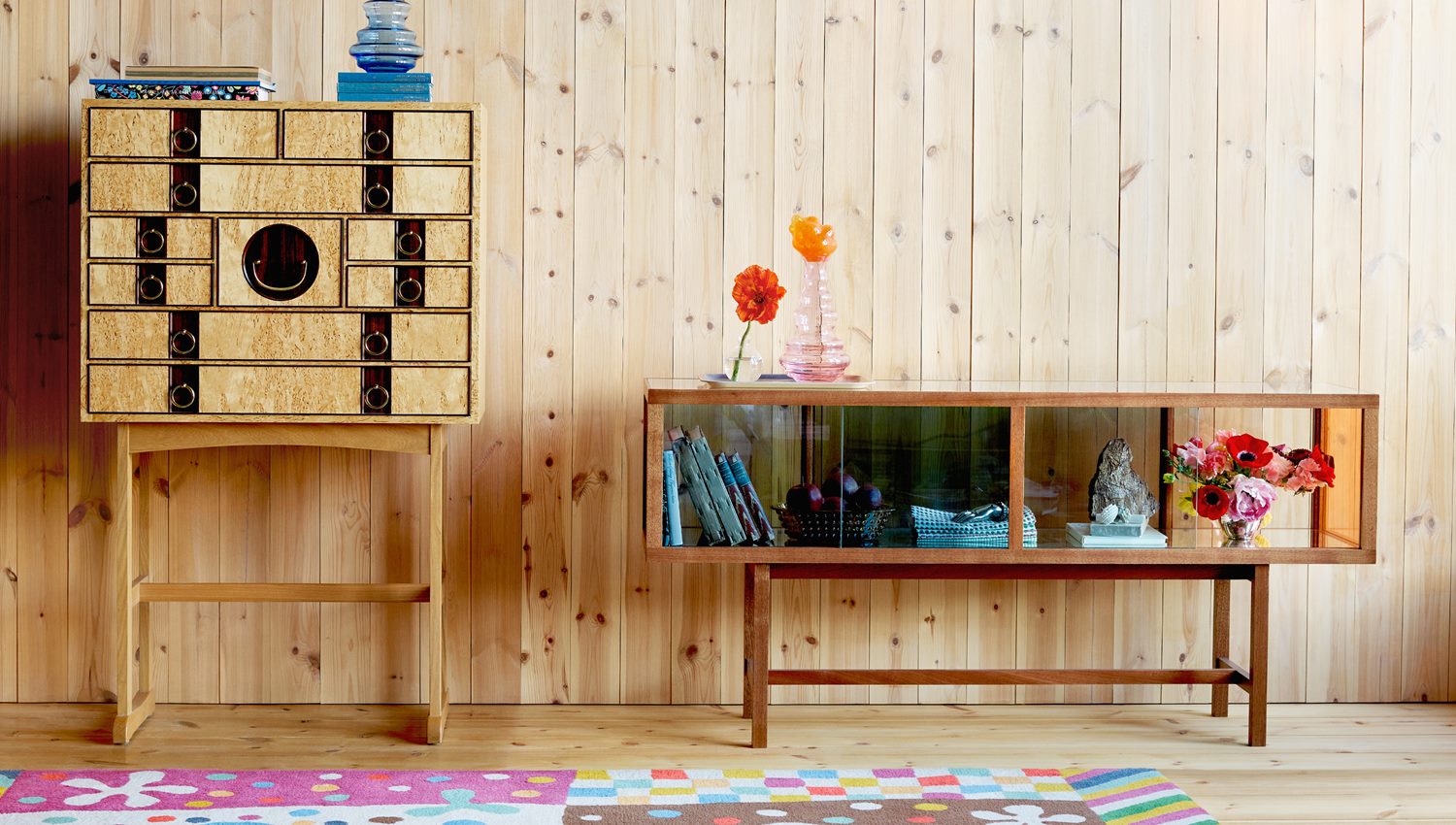A number of new products from five different designers will be launched in this year’s spring exhibition at Svenskt Tenn. Among the new products are Eva Schildt’s sideboard with coloured glass panels, Sara Söderberg’s breakfast dishes and Frida Fjellman’s sculptural water carafes in playful colours.
Focus on craftsmanship in the New Dawn spring exhibition
The exhibition New Dawn opens at Svenskt Tenn on April 26. The name of the exhibition relates to faith in the future.
Svenskt Tenn invites you to a spring exhibition offering hope and inspiration. We have decided to launch five different collaborations at a single event – a sideboard, a set of breakfast dishes, water carafes, a hurricane lantern and a collection of table linens,
says Thommy Bindefeld, Creative Director at Svenskt Tenn.
Kvintett (Quintet) Sideboard – Eva Schildt
Svenskt Tenn has been collaborating with designer Eva Schildt for several years. Among other items she has designed the popular Oolong table and the Vienna rug. Schildt has now created a low, horizontal display cabinet/sideboard in mahogany with coloured glass panels that together create new colour combinations. The Kvintett sideboard’s name derives from the five colours of the glass: warm grey, red, sky blue, aqua and orange. The colours and idea to create a modern glass cabinet inspired by old glass verandas became the starting point for Schildt’s design. Kvintett is made by Tre Sekel cabinetmakers in Västergötland.
Classic display cabinets are very beautiful but often take up a lot of space, making them difficult to place. I wanted to create a display cabinet that you can furnish with, and that has multiple functions. This cabinet can be placed in the middle of a room and used as a sideboard,
says Schildt.
A hurricane lantern, a breakfast set and a water carafe
Peter Nylander studied at Beckmans College of Design and his work borders on both product design and handicrafts. For Svenskt Tenn he has created Stormlykta Lux (Lux Hurricane Lantern), which is optically blown at Reijmyre Glassworks. The lantern is named after the Latin word for light.
When glass is blown in an optic mould, stripes appear in the glass, which creates an incredibly exciting light show in the room where the lantern is placed. Lux has a very elegant shape with its delicate glass and brass plate and feet. It is suitable for both indoor and outdoor use and can be used with taper or pillar candles,
says Bindefeld.
Sara Söderberg is a sculptor and designer educated at Konstfack University of Arts, Crafts and Design who previously made a plate shaped like a porcelain shell that is in Svenskt Tenn’s range. With her experience from the restaurant world, she has designed Gryning, a functional and beautiful breakfast set, made at Lidköping’s Porcelain Factory. Gryning is made of white clay with a beautiful wavy relief, a reminder that the products are created by hand.
With Gryning I wanted to create dishes that could be placed on a table set by Svenskt Tenn’s founder, Estrid Ericson,
says Söderberg.
Frida Fjellman is a trained glass artist from Konstfack and Pilchuck Glass School, in Washington. For Svenskt Tenn, she has designed two versions of a water carafe with an aesthetic bordering on both everyday objects and art. She has formed a sculpture that can be used as a vase or a carafe. The cork is inspired by rising smoke (a smoke signal) as a nod to communication and conversation at the dinner table. The Rök (Smoke) Carafe is made at Reijmyre Glassworks.
Frida Fjellman has an exciting and playful design language that is visible in these beautiful glass water carafes where the free form of the bottle stopper contrasts clearly with the design of the bottle,
says Bindefeld.
The project for Svenskt Tenn has been an equal opportunity project where everyone’s opinion is equally valued, and it has been extremely enjoyable working together. I hope that pleasure is reflected in these carafes, which are both a table sculpture and a utilitarian item,
says Fjellman.
Jean-Baptiste Lescudé – Persephone fabric pattern
The spring exhibition also sees the launch of a tablecloth collection designed by French architect Jean-Baptiste Lescudé. The collection is named after the Greek goddess Persephone, who is associated with the return of spring. In the abstract pattern we see an interpretation of petals, buds, leaves and seeds that depict all the characteristics of spring.
The common thread between the products launched in the spring exhibition is the presence of craftsmanship, where you can see traces of the hand’s movement in the working process, but also the meeting of colours. The Persephone pattern is block-printed by hand in India, where one colour is printed on top of another to produce a third colour. Josef Frank worked in a similar way when colouring his patterns,
says Bindefeld.
What Svenskt Tenn does is particularly important – to trust both renowned designers and young designers who are just starting out. It was very interesting to work with a brand that believes in craftsmanship with a rich and well-defined cultural territory. It is impressive to work with such a heritage. When I was designing the patterns, I always had in mind: What would Josef Frank have thought of this idea?
concludes Jean-Baptiste Lescudé.

